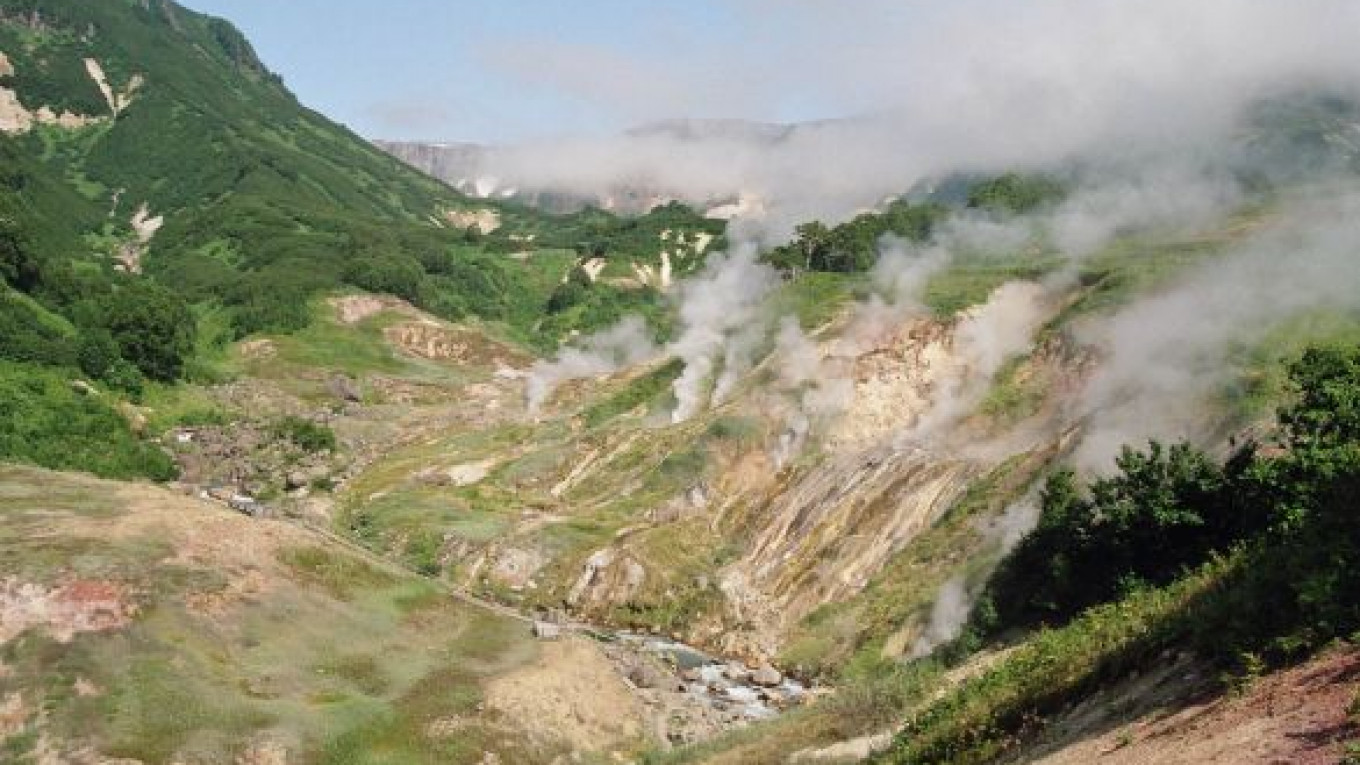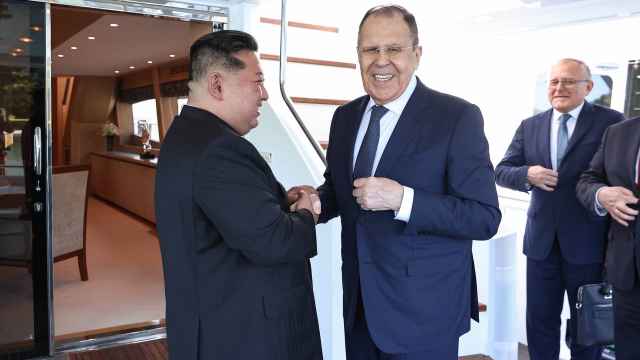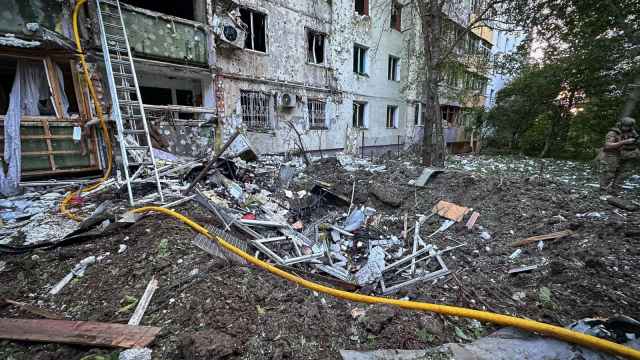ASTRAKHAN – Even before the October Revolution arrived, Russia’s first protected natural area was set up on the slopes of the Barguzin mountain range and around Lake Baikal in 1916, laying the foundation for a national park system originally designed to keep visitors out.
Almost a century later, there are hundreds of specially designated sites covering 7 percent of the country’s total landmass. But their mission is undergoing a fundamental transformation as vaguely worded changes to laws at the end of last year are now compelling the parks to attract tourists and earn money — resulting in a philosophical struggle that reflects the ambivalence the state has had toward the parks over the years.
“In 1951 Josef Stalin almost destroyed [the system], liquidating 70 percent of the reserves. … Later Nikita Khrushchev carried out his destructive policy, but the nature reserves survived. Unfortunately, today the authorities want [reserves] to make money instead of protecting the wildlife,” said Mikhail Kreindlin of Greenpeace.
And a group of environmentalists has strongly opposed the initiative, which they warn might lead “to irreparable consequences” for the environment.
The 235 protected areas in Russia are divided into three main categories. The most common and exclusive are the 102 zapovedniks, or nature reserves, covering 330,000 square kilometers (about the size of Poland). These are nature reserves established under a Soviet-designed system that essentially aims to keep them forever wild and free of economic and human activity, except for park rangers and scientists.
The Kronotsky nature reserve in the north of the Kamchatka Peninsula is one of the most famous reserves, thanks to its geysers, volcanic mountains and bears. The Slolby nature reserve in Krasnoyarsk is also well known for its beautiful geological formations, while the Polistovsky nature reserve in the Pskov region is home to the biggest bog in Europe.
There are also 81 zakazniks, or protected areas, around the country.
They are less protected and economic activities, such as logging, mining, livestock grazing and hunting, can be allowed on their territory.
The country’s 52 national parks, which were originally designed to encourage visitors from the general public, began to be established only in 1981.
The novel idea of such protected areas luring throngs of tourists, which until recently was illegal, has been ardently promoted by the Natural Resources and Environment Ministry and received backing from President Vladimir Putin.
The amendments passed and signed in November 2011 vaguely say that ecological and educational tourism should be one of the key priorities for Russia’s special reserved areas. But the document doesn’t specify how it should be supervised and organized.
The government allotted 2.4 billion rubles ($77.6 million) to be spent on ecological tourism development from 2011 to 2013.
“This work has never been done on such a scale — in Russia, it’s the first time,” then-Natural Resources and Environment Minister Yury Trutnev told Putin at an August meeting.
It is expected that the reserves will eventually cover their own expenses thanks to tourism revenue, but officials haven’t specified when.
But it’s clear that Russian authorities are modeling their effort on the U.S. national park system.
“Yellowstone National Park is visited by 2 million tourists [annually], while we in Kamchatka have only a few thousand people visiting per year,” Putin said at a 2010 Cabinet meeting. “It’s obvious that this results from a lack of normal infrastructure for tourists, which would help people and protect nature.”
Those park directors who favor tourism at their nature reserves take regular trips to the United States and European countries, including Norway, Estonia and Sweden to learn about tourism practices in protected areas, one director said on condition of anonymity.
Old Thinking
And, naturally, big changes bring big conflicts.
The reserves are “first and foremost scientific organizations” focused on conservation, said Nina Litvinova, director of the Astrakhan Biosphere Nature Preserve.
“They are simply not fit for tourists to enjoy nature,” she said in a recent interview at her office in Astrakhan.
But the money allotted for tourism development has been mainly directed toward 10 nature reserves and only two national parks, even though naturalists say it would be more logical to develop the national parks, which were originally created for tourists.
Kreindlin, who oversees protected areas for Greenpeace, said that the initiative lacks a “real system” on how the process should be developed.
“Some of the [reserves] just do tourism more actively than the others,” Kreindlin said in an interview at Greenpeace Moscow headquarters. “A few do it wisely, concentrating all the infrastructure outside the territory and doing excursion tours, while others choose a different way and openly start organizing fishing trips to protected areas.”
Litvinova recalled that when the country first started doing eco tourism actively in the 1990s, it was considered “a temporary measure to earn some money.”
“But there is nothing more permanent than temporary: In the end, it was decided that the nature reserves could make money,” she said.
Some nature reserve managers and ecologists say that the policy is as unrealistic as ordering the army to fund and provision itself.
Litvinova has run the 93-year-old Astrakhan reserve for almost a decade, and she openly opposes the idea of mass tourism. She says it suits only a handful of reserves that traditionally attract many tourists, while many other places are only interesting for professionals and too boring for the general public.
Up to 2,000 tourists are allowed to visit the Astrakhan nature reserve every year, but in reality the flow of tourists has been very low in recent years — ranging from 500 to 600 people annually.
And Litvinova is not looking for more visitors. The Astrakhan reserve is made up of islands and reed beds in the Volga Delta and the only possible way to get around is by boat. If boat traffic increases, Litvinova warned, animal life will disappear very soon.
As rangers travel along the narrow canals, flocks of birds — many of whom are listed as endangered species — take flight. Below the waterline, representatives of over 60 fish species swim in the waterways around the preserve, which feed into the Caspian Sea.
“People don’t come to this area to enjoy nature. They want to hunt and fish here,” she said.
Shortly after the interview, Litvinova caught two boats on the reserve’s territory that had crossed over illegally from a nearby fishing club.
Opening Up
The enthusiasm to exploit is not just localized.
While lobbying the legislation in August, Trutnev told then-Prime Minister Vladimir Putin that the number of tourists visiting protected areas could “be doubled from 6.5 million people to 12 million in 2013” — but only with an expansion of infrastructure.
According to the plan, the selected reserves should spend the allotted funds on constructing hotels, museums, paths and visitor centers.
Some environmentalists agree with Litvinova that it doesn’t make sense to encourage active tourism at all nature reserves because many of them, like those with bogs, swamps, or other formidable environments, are neither interesting for laymen nor picturesque. Such territories, they say, have scientific interest or preserve some rare landscapes or plants, but are not an attraction for tourists.
Natalia Danilina, a Public Chamber member and director of Moscow’s Zapovedniki ecological center, argues that tourism is necessary for nature reserves.
“Currently, [tourism] is developing in the shadows, and we need to work out legal tools to make it transparent,” Danilina said in a telephone interview. “There should be concrete guidelines to regulate it.”
She said that some of the reserves running tourism pilots were well chosen. Kamchatka’s Kronotsky nature reserve, for example, has welcomed tourism for years and is seen by some as a template for success. The website of the Kronotsky reserve offers a list of activities, including one-day hikes and boat trips with prices ranging from 360 rubles ($10.50) to 35,000 rubles. That does not, however, include the round-trip airfare from Moscow, which can run to 42,000 rubles in the peak summer season.
Such income from tourism might seem tempting to other reserves, given that a nature reserve ranger’s average monthly salary is 4,000 rubles.
But Kreindlin of Greenpeace insists that the consequences might be the opposite if making money replaces aspirations to protect nature.
Back Scratching
The Astrakhan reserve has a village located at the border of its protected territory, where several families of workers and rangers live in neat uniform Soviet-built one-story wooden houses standing in an even line along the riverbank. There are also the decaying structures of a disused museum and food store.
Observing Litvinova at work, it becomes clear that her current headache is not tourism, but the real threat of wildfires spreading a pall of smoke all around the protected area and fishermen encroaching on its borders.
She is one of the few reserve directors who dare to openly criticize the federal initiative. For that she gets punished when it comes to state funding.
“We are not provided funding on the grounds that we are against tourism at nature reserves,” she said. “If you are opposed to it, you won’t get anything.”
Instead, she proposed renovating the museum, which has been out of service for four years, to hold lectures and install web cameras around the territory for online monitoring, but she was refused financing.
The reserve’s budget of 23 million rubles ($696,900) has not been increased for four years. Most of the money is spent on salaries for the staff of 110 people, Litvinova said.
A source at a different nature reserve confirmed on condition of anonymity that only those directors “who openly favor the idea of tourism development at official meetings” get rewarded with an increase in financing.
It’s no surprise that directors of more than a dozen nature reserves and national parks have been replaced in the past several years.
Those who don’t side with the [tourism] policy “are being replaced with effective managers, whose main target is to promote it,” Kreindlin said.
Olympic Start
The first real changes to legislation easing access to reserved areas were passed when the government started preparations for the 2014 Sochi Olympics. A large number of Olympic facilities have been planned on specially protected territories: Sochi’s National Park and the Caucasus Nature Reserve, which is a UNESCO heritage site.
Prior to Russia’s winning the Olympics bid in 2007, massive construction had been prohibited on the territory of national parks.
“The country’s laws were hastily changed, justifying the absence of obligatory environmental impact studies, confiscation of land for Olympics construction … and withdrawal of the special protected status for territories of designated natural value,” opposition politicians Vladimir Milov and Boris Nemtsov wrote in their 2009 report on the Sochi Olympics preparations.
In order to legalize the construction, the boundaries of a significant part of the protected territory were redrawn, freeing up desirable land plots. Later, for the sole purpose of the Sochi Olympics, a bill was passed in the space of just two weeks in 2009 that leveraged a loophole to permit the development of sporting facilities and social infrastructure within national parks. Those facilities are envisaged to be in use after the games.
“The 2014 Olympics will leave an odor in the country’s nostrils for many years to come. The most important thing it has demonstrated so far is that under the aegis of any ‘needed’ project, you can rewrite any law — or simply close your eyes to their lack of enforcement,” the Bellona environmental organization concluded in a commentary last year.
But both Russian officials and the International Olympic Committee have repeatedly indicated that they share the concerns of the environmentalists.
After the Sochi precedent, the state started promoting the idea of tourism in preserved areas.
Currently, the Russian government is paving the way for the construction of a cluster of ski resorts and roads in the North Caucasus region.
Dubbed “Altitude 5642,” the project envisions five mountain ski resorts with extensive infrastructure that will host up to 10 million tourists annually. It is feared that the large-scale effort will affect two biosphere nature reserves, two national parks and a World Heritage Site.
The amendments on preserved areas also allow construction at biosphere research and test sites, which are areas specially designated for scientific investigation, particularly into man’s impact on nature.
Project leaders have dismissed speculation that the cluster will have any negative effect on the unique environment and emphasize that it will create numerous jobs in the turbulent region.
Wolf in the Fold
Green organizations and activists point out that plans to develop protected areas highlight the greater problem of the absence of a professional and independent authority to oversee the environmental protection of Russia’s territories.
Today, the Natural Resources and Environment Ministry regulates both environmental protection and extractive industries. Environmental campaigners have lobbied hard for the establishment of an independent environment ministry or agency, but to no avail.
“From 1988 to 2000, there was a real independent state institution in charge of the environment that could not be influenced from the outside,” said Greenpeace’s Kreindlin, who used to work for the government’s environmental watchdog when it still had separate ministerial status in the 1990s. “It was a strict system of management.”
But one of Putin’s first decrees when he came to power in 2000 was an order to disband the State Committee for Environmental Protection and pass its functions to the Natural Resources Ministry.
Danilina of the Public Chamber agrees that if the ministry wants to develop tourism in protected areas, a new and empowered structure is needed. “Currently, the [ministry’s] approach to management is rather weak.”
The recent governmental reshuffle following Putin’s return to the Kremlin hasn’t yielded any ministerial changes relevant to environmental policy. Although the Federal Tourism Agency — which told The Moscow Times that it has nothing to do with the nature reserve initiative — was transferred from the Sports Ministry to the Culture Ministry.
But Danilina is optimistic about the side effects of opening up the country’s natural beauty for broader public inspection; she believes it will increase environmental awareness among the population.
“There are places that people would like to see with their own eyes. We can’t forbid them,” she said. “If a person sees from an observation tower how a bear walks in the forest, he will never kill it.”
And she sees the public outcry about the new program as a symptom of a more endemic problem. “The wave of criticism is mainly because people in Russia don’t believe that a law can work,” Danilina said.
A Message from The Moscow Times:
Dear readers,
We are facing unprecedented challenges. Russia's Prosecutor General's Office has designated The Moscow Times as an "undesirable" organization, criminalizing our work and putting our staff at risk of prosecution. This follows our earlier unjust labeling as a "foreign agent."
These actions are direct attempts to silence independent journalism in Russia. The authorities claim our work "discredits the decisions of the Russian leadership." We see things differently: we strive to provide accurate, unbiased reporting on Russia.
We, the journalists of The Moscow Times, refuse to be silenced. But to continue our work, we need your help.
Your support, no matter how small, makes a world of difference. If you can, please support us monthly starting from just $2. It's quick to set up, and every contribution makes a significant impact.
By supporting The Moscow Times, you're defending open, independent journalism in the face of repression. Thank you for standing with us.
Remind me later.






